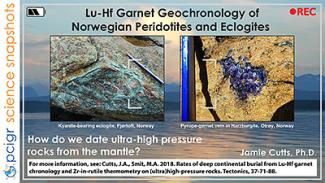PCIGR has developed analytical geochronology techniques that allow for excellent levels of instrument precision and collection of high-quality data for users.
Major developments in geochronology methodology and instrumentation have made possible our ability, both rapidly (via laser ablation) and precisely (via multicollector TIMS and zircon chemical abrasion), to date a variety of geological materials that have a wide range of closure temperatures.
PCIGR has established a chemical abrasion technique (CA-TIMS) that achieves a precision of better than 0.1% (and approaching 0.02% for specific samples) on dates of U-Th-Pb-bearing accessory minerals in mafic and ultramafic rocks. These advances have allowed for important discoveries related to the crystallization ages and duration of magmatism in major mafic layered intrusions.
PCIGR is also a contributor to the EARTHTIME initiative, which aims to produce a highly resolved, calibrated geologic timescale through intercalibration of common enriched isotope spikes and synthetic U-Pb isotope solutions.
Examples of innovative geochronological research that have benefitted from PCIGR’s high-precision data include:
- Integrating geochronology (U-Pb, Lu-Hf) for studying, in detail, the orogenic cycles in the Western Canadian Cordillera.
- Precise dating of intrusive-related hydrothermal ore deposits and fluid circulation history in continental arc environments.
- Determining emplacement history of Phanerozoic large igneous provinces to evaluate rapid (~1 million years) versus protracted magmatism and potential effects on the environment.
- High-precision dating of large layered mafic-ultramafic intrusions to derive magma production/flux and cooling rates.
Click on the Science Snapshots below to see details of how analyses performed by PCIGR have benefitted geochronological research.


